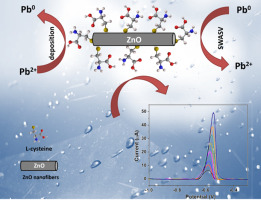Journal of Molecular Liquids ( IF 5.3 ) Pub Date : 2020-04-03 , DOI: 10.1016/j.molliq.2020.113041 Vitor H.B. Oliveira , Fernanda Rechotnek , Elisangela P. da Silva , Vicente de Sousa Marques , Adley F. Rubira , Rafael Silva , Sidney A. Lourenço , Edvani C. Muniz

|
Environmental pollution caused by heavy metals is a world concern, mainly because it can be accumulated in the human body, causing serious health problems. Thus, an accurate method to determine the concentration of heavy metals, lead (II) ions for instance, for water quality control is of great significance to the protection of the environment and human health. Herein, we reported the synthesis of a zinc oxide nanofibers/L-cysteine (ZnO_Lcys) nanocomposite and its use as electrodes for the electrochemical sensing of Pb2+ ions. First, ZnO nanofibers were prepared by electrospinning method followed by annealing. Then, L-cysteine was anchored into the surface of ZnO nanofibers for producing the work electrode. Square wave anodic stripping voltammetry (SWASV) was applied for the detection of Pb2+. The ZnO_L-cys modified glass carbon electrode (GCE/ZnO_L-cys) showed a considerably higher response in relation to the non-functionalized ZnO nanofibers. Several optimization parameters were studied and under optimized conditions the GCE/ZnO_L-cys electrode displayed excellent sensitivity, selectivity, and stability. The detection limit (LOD) was 0.397 μg·L−1 in the linear range of 10–140 μg·L−1. Also, the sensor was successfully applied for the Pb2+ ion in real samples, with recoveries of 94% and 95%. The success of electrochemical performance is a result of the high porosity of nanofibers combined with Lewis acid-base interaction of L-cysteine, making it great material for Pb2+ detection in real sample.
中文翻译:

基于L-半胱氨酸功能化的ZnO纳米纤维的Pb 2+离子敏感电化学传感器
重金属造成的环境污染是世界关注的问题,主要是因为它可以在人体中积累,造成严重的健康问题。因此,确定用于控制水质的重金属(例如铅(II)离子)浓度的准确方法对保护环境和人类健康具有重要意义。在这里,我们报道了氧化锌纳米纤维/ L-半胱氨酸(ZnO_Lcys)纳米复合材料的合成及其作为电化学检测Pb 2+离子的电极的用途。首先,通过电纺丝法制备ZnO纳米纤维,然后进行退火。然后,将L-半胱氨酸锚定在ZnO纳米纤维的表面中以制备工作电极。方波阳极溶出伏安法(SWASV)用于检测Pb 2+。ZnO_L-cys修饰的玻璃碳电极(GCE / ZnO_L-cys)相对于未官能化的ZnO纳米纤维表现出明显更高的响应。研究了几个优化参数,在优化条件下,GCE / ZnO_L-cys电极表现出出色的灵敏度,选择性和稳定性。检测极限(LOD)为0.397微克·L -1在10-140微克的线性范围·L -1。此外,该传感器已成功应用于实际样品中的Pb 2+离子,回收率分别为94%和95%。电化学性能的成功归因于纳米纤维的高孔隙率以及L-半胱氨酸的路易斯酸碱相互作用,使其成为实际样品中Pb 2+检测的重要材料。









































 京公网安备 11010802027423号
京公网安备 11010802027423号